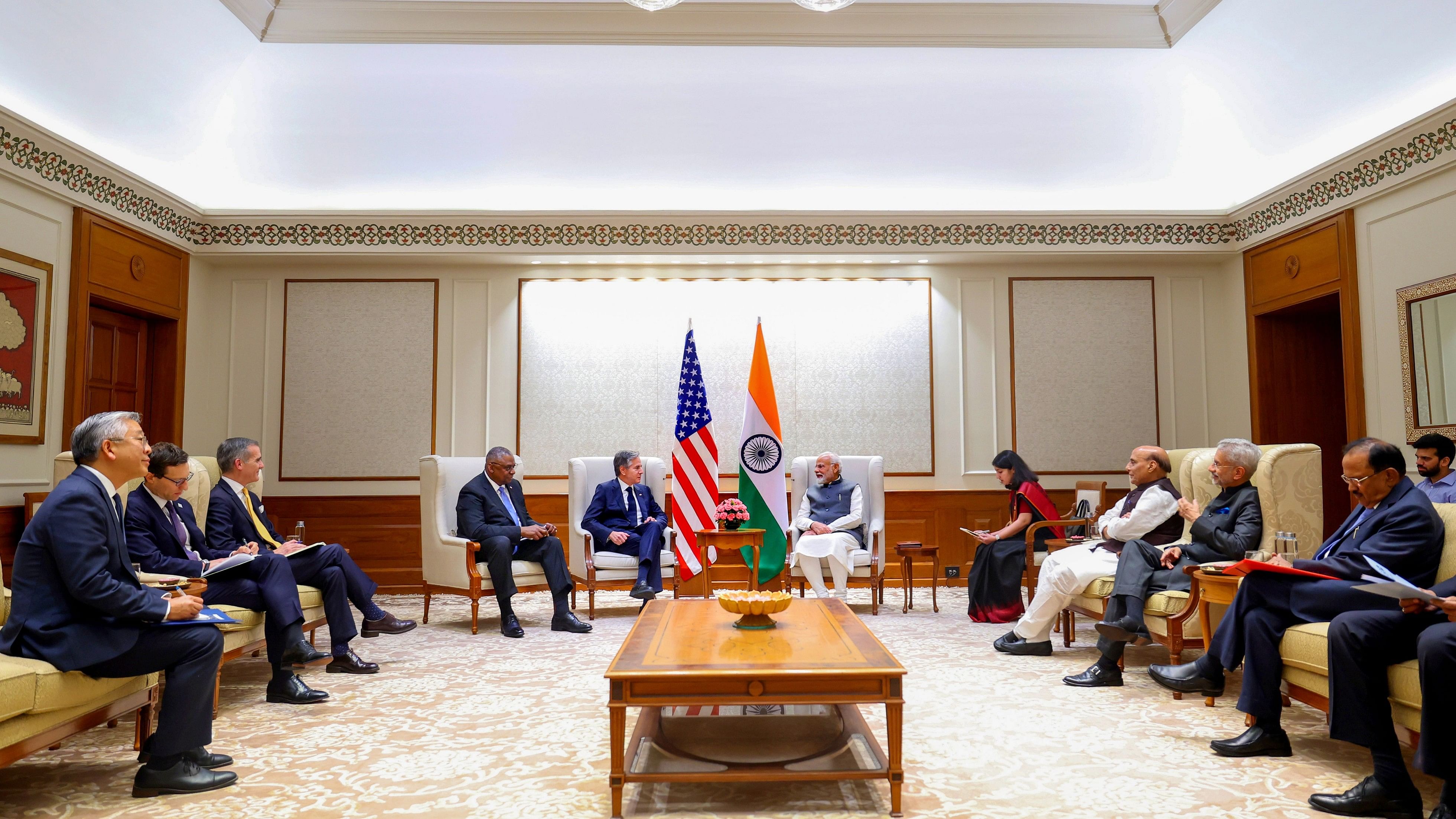
Prime Minister Narendra Modi meets US Secretary of State Antony Blinken and Secretary of Defense Lloyd Austin, in New Delhi, Friday, Nov. 10, 2023. Defence Minister Rajnath Singh, and External Affairs Minister S Jaishankar are also seen.
Credit: PTI Photo
The fifth 2+2 dialogue between India and the United States took place on November 10 against the backdrop of increasing concern over the Israel-Hamas conflict, the continuing conflict in Ukraine, and disquiet about China’s actions in the Taiwan Strait. The dialogue brings together India’s External Affairs Minister and Defence Minister, and the US Secretary of State and Defence Secretary for an annual discussion on defence and security matters.
The joint statement from this year’s dialogue mentions the situation in West Asia, though quite clearly India stuck to its position of condemning the terrorist attacks against Israel while also reiterating a Two-State Solution, calling for the release of hostages, and aid to Palestinian civilians. The two sides discussed the possible impact of this current escalation of tensions on the India-Middle East Europe Economic Corridor (IMEEC) announced at the New Delhi G20 Summit. The portion of the statement on Ukraine was quite like the G20 statement, which expressed concern over the situation in Ukraine without directly naming or condemning Russia.
Surprisingly, there was no mention of either China or Pakistan in the statement. The allusion to China was in an indirect reference to India’s and the US’ “strong commitment to safeguarding a free, open, and inclusive Indo-Pacific through mechanisms like the Quad”, a nod to both countries watching developments in the maritime space around China closely.
However, there does not seem to have been much progress on one of the issues bedevilling India-US ties lately — the diplomatic spat between India and Canada. The US has stuck to its guns suggesting again that India should work with Canada on its investigation.
Quite clearly, the focus of the dialogue was defence co-operation, which has become a bedrock of the bilateral relationship. India has bought weapons worth more than $20 billion from the US since 2008, making the US one of the top three suppliers of defence equipment to India. India today holds the greatest number of military exercises with the US. In the last few years, the defence relationship has moved from a mere buyer-seller relationship to co-production and co-development of weapons systems. The idea is for the two states to collaborate on defence industrial co-operation to build a defence industrial base in India and make it into a global defence hub. At this year’s dialogue, New Delhi and Washington announced the co-production of an infantry combat vehicle.
The two states have also agreed to increase investments in India’s maintenance, repair, and overhaul (MRO) sector, including aircraft maintenance and mid-voyage repair of US naval vessels. There were also commitments from the US industry to further expand India’s MRO capabilities, including for the repair of aircraft and unmanned aerial vehicles.
Among other things, the US reiterated its support for India’s membership in the International Energy Agency (IEA).
A key takeaway on the security front was the finalisation of a Security of Supply Arrangement (SOSA), which will further integrate the defence industrial ecosystems of both countries while strengthening supply chain resilience. The SOSA will allow India to request priority delivery for their contracts and orders with US firms. The finalisation of the SOSA is an indicator of the importance that the US gives to India as only 13 other countries have this agreement with the US.
An interesting announcement in the arena of space co-operation is the creation of a sub-working group, under the India-US Civil Space Joint Working Group, to focus on ‘Space Commerce’, adding ‘Planetary Defence’ as a topic under the India-US Civil Space Joint Working Group led by NASA and ISRO, and engagement on the human space flight programme for the International Space Station.
In the case of semiconductors, the two sides discussed collaborating in training and capacity building; some major investments have already been made in India’s semiconductor ecosystem by US companies under the (India-US Initiative on Critical and Emerging Technology (iCET). The reference in the joint statement to the Mineral Security Partnership Principals’ Meeting reflects the two states’ commitment to friend-shoring and building “diverse, secure and responsible global critical mineral supply chains”.
The latest 2+2 dialogue is a sign that the US and India are developing ‘habits of cooperation’ despite differences of opinion on some issues. It shows that New Delhi and Washington are deeply invested in strengthening their co-operation and that the relationship is gradually maturing into one where they can agree to disagree on many issues without taking their eyes off the larger goal of managing China’s rise.
(Uma Purushothaman is Assistant Professor, Department of International Relations, Central University of Kerala.)
Disclaimer: The views expressed above are the author's own. They do not necessarily reflect the views of DH.